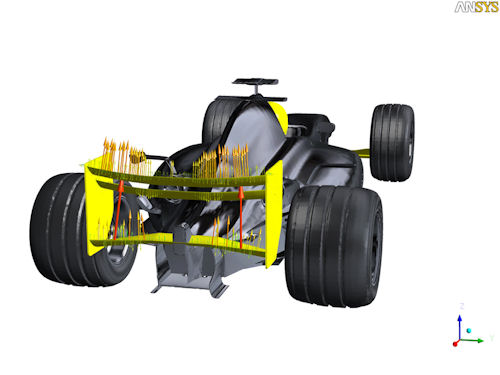Fluid Dynamics Technology Tips: Adjoint Solver
Latest News
August 9, 2013
Dear Desktop Engineering Reader:
So, I’m on the phone with a contact at ANSYS. He wants to show me a new solver called Adjoint that’s been slipped into ANSYS Fluent CFD (computational fluid dynamics) software version 14 and 14.5. By “slipped” I mean, it’s in there, it’s easily accessible from the Fluent console. ANSYS talks about it, but there’s been no awareness campaign on it. For example Howard Stern has not mentioned it once. This leads me to believe—and this is just a guess; my contact would neither confirm nor deny anything—that what you have here with Adjoint is the onset of a technology that may be years away from done. Still even with that caveat, I think that Adjoint could change how you go about your job.
 |
ANSYS calls Adjoint a smart shape optimization tool, an acknowledgment that it’s the design’s shape that is the most important factor when you’re trying to minimize, say, drag on a car or pressure drop in a pipe. OK, now, you know how you normally approach a CFD analysis: input your geometry, set your boundary conditions and whatnot, then hit run. Next, you investigate the results and start guessing—educated guesses, but guesses no less. You then fiddle a few critical quantities like drag, lift, or pressure drop, run some more simulations, repeat the process, and otherwise plod your way toward your design objective.
And you know the grind here. Shapes can have a hundred or a gazillion parameters, depending on their complexity. Zoning in on the relevant parameters to work with is not that clear cut. You need to rerun the CFD simulation for each design change and, 144 simulations later and counting, time has marched on and you’re nowhere near done. These are the situations where you would fire up Adjoint.
Adjoint performs a sensitivity analysis directly on your preliminary CFD results data. Its aim is to find the optimal solution based on your goals, such as drag reduction, maximizing lift over draft ratio, or reducing pressure drop. It automatically identifies the section of the shape you need to modify, and it automatically guides shape optimization by recommending how to modify the shape. Remember, it does all this from your CFD simulation results, regardless of the number of design variables and without making you run trial-and-error CFD simulations endlessly. And it apparently does all of this quickly, according to ANSYS.
To help save you some more time, the Adjoint solver also works with mesh morphing technologies. What this means for you is that you do not have to redefine the geometry or re-create the computational mesh after the Adjoint solver indicates the section of a shape to modify, how to do it, and you agree. Instead, you can use mesh morphing to automatically adjust the design shape and the computational mesh according to Adjoint’s recommendations.
Let me say here that Adjoint does not eliminate the need to do more CFD simulations. But it can drastically lower the number of simulations you have to run to determine an optimal shape. That can potentially save you a slew of hours, days, or even weeks of effort.
Currently, key application areas for the Adjoint solver include those physics phenomena I mentioned here and their siblings. Today’s Check It Out link over there takes you to a dedicated web page on Adjoint technology that ANSYS built. You’ll find lots of additional information to be had there, including an easy-to-read article, a technical brief, an on-demand webinar, and a demo. Down at the bottom of the page is a short video as well. This is good stuff.
Thanks, Pal. – Lockwood
Anthony J. Lockwood
Editor at Large, Desktop Engineering
Learn more about Adjoint solver in ANSYS Fluent versions14 and 14.5.
Subscribe to our FREE magazine, FREE email newsletters or both!
Latest News
About the Author
Anthony J. Lockwood is Digital Engineering’s founding editor. He is now retired. Contact him via [email protected].
Follow DE





